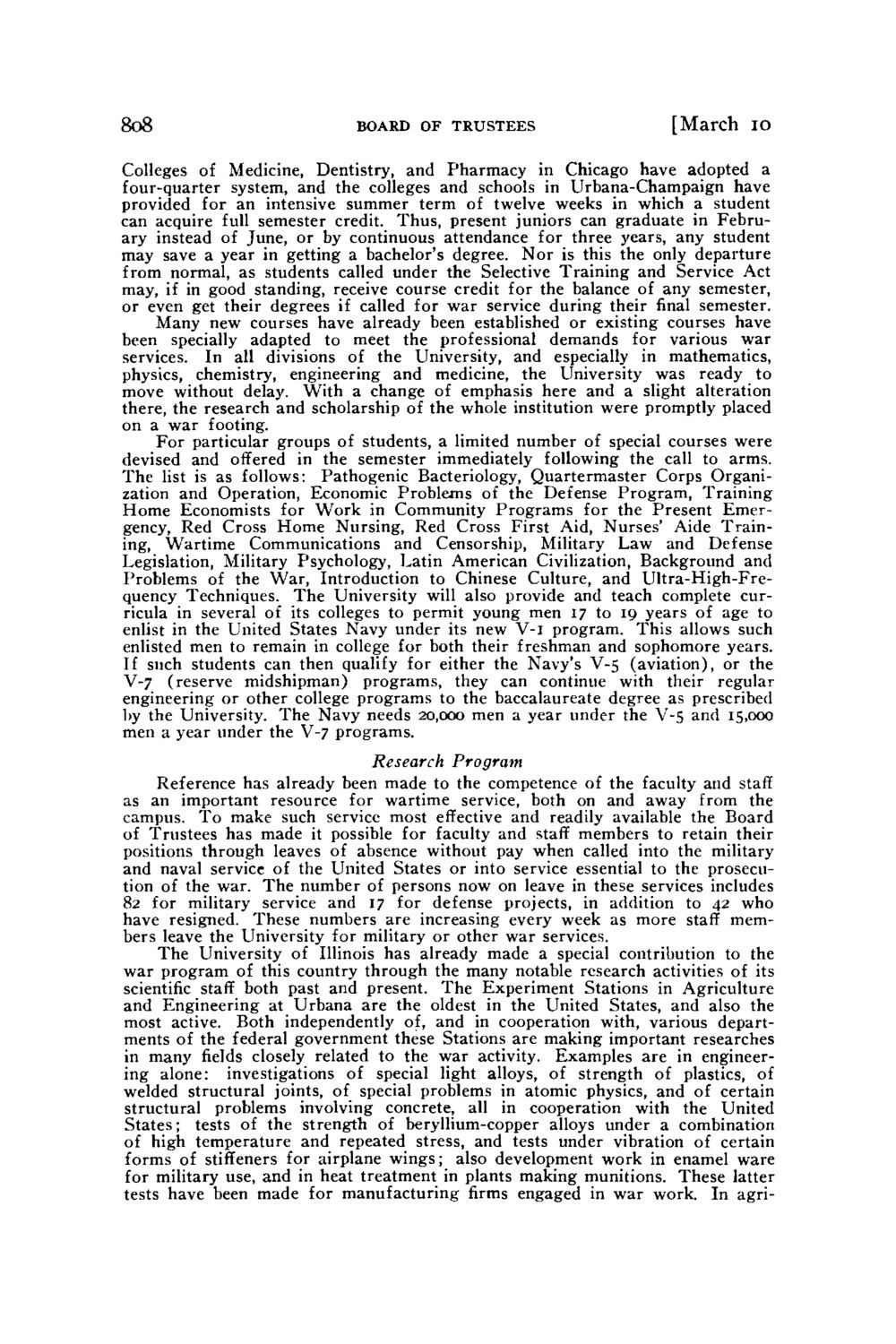| |
| |
Caption: Board of Trustees Minutes - 1942
This is a reduced-resolution page image for fast online browsing.

EXTRACTED TEXT FROM PAGE:
8o8 BOARD OF TRUSTEES [March 10 Colleges of Medicine, Dentistry, and Pharmacy in Chicago have adopted a four-quarter system, and the colleges and schools in Urbana-Champaign have provided for an intensive summer term of twelve weeks in which a student can acquire full semester credit. Thus, present juniors can graduate in February instead of June, or by continuous attendance for three years, any student may save a year in getting a bachelor's degree. Nor is this the only departure from normal, as students called under the Selective Training and Service Act may, if in good standing, receive course credit for the balance of any semester, or even get their degrees if called for war service during their final semester. Many new courses have already been established or existing courses have been specially adapted to meet the professional demands for various war services. In all divisions of the University, and especially in mathematics, physics, chemistry, engineering and medicine, the University was ready to move without delay. With a change of emphasis here and a slight alteration there, the research and scholarship of the whole institution were promptly placed on a war footing. For particular groups of students, a limited number of special courses were devised and offered in the semester immediately following the call to arms. T h e list is as follows: Pathogenic Bacteriology, Quartermaster Corps Organization and Operation, Economic Problems of the Defense Program, Training H o m e Economists for W o r k in Community Programs for the Present Emergency, Red Cross H o m e Nursing, Red Cross First Aid, Nurses' Aide T r a i n ing, Wartime Communications and Censorship, Military Law and Defense Legislation, Military Psychology, Latin American Civilization, Background and Problems of the W a r , Introduction to Chinese Culture, and U l t r a - H i g h - F r e quency Techniques. T h e University will also provide and teach complete curricula in several of its colleges to permit young men 17 to 19 years of age to enlist in the United States Navy under its new V - l program. This allows such enlisted men to remain in college for both their freshman and sophomore years. If such students can then qualify for either the Navy's V-5 (aviation), or the V-7 (reserve midshipman) programs, they can continue with their regular engineering or other college programs to the baccalaureate degree as prescribed by the University. The Navy needs 20,000 men a year under the V-5 and 15,000 men a year under the V-7 programs. Research Program Reference has already been made to the competence of the faculty and staff as an important resource for wartime service, both on and away from the campus. T o make such service most effective and readily available the Board of Trustees has made it possible for faculty and staff members to retain their positions through leaves of absence without pay when called into the military and naval service of the United States or into service essential to the prosecution of the war. T h e number of persons now on leave in these services includes 82 for military service and 17 for defense projects, in addition to 42 who have resigned. These numbers are increasing every week as more staff members leave the University for military or other war services. T h e University of Illinois has already made a special contribution to the war program of this country through the many notable research activities of its scientific staff both past and present. T h e Experiment Stations in Agriculture and Engineering at Urbana are the oldest in the United States, and also the most active. Both independently of, and in cooperation with, various departments of the federal government these Stations are making important researches in many fields closely related to the war activity. Examples are in engineering alone: investigations of special light alloys, of strength of plastics, of welded structural joints, of special problems in atomic physics, and of certain structural problems involving concrete, all in cooperation with the United S t a t e s ; tests of the strength of beryllium-copper alloys under a combination of high temperature and repeated stress, and tests under vibration of certain forms of stiffeners for airplane wings; also development work in enamel ware for military use, and in heat treatment in plants making munitions. These latter tests have been made for manufacturing firms engaged in war work. In agri-
| |